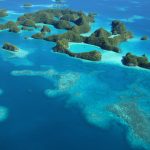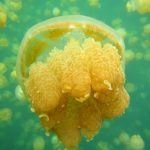Dr Kelvin Balakrishnan - Ballajura
Palau is an archipelago of about 200 islands in Micronesia, east of the Philippines, with a population of about 20, 000. Although there are many things to see and do in Palau, it is known for its scuba diving. (It was reported as one of Jacques Cousteau's favourite dive sites in the world. ) I was lucky enough to go to Palau and spend a week diving.
The biggest attraction was the diversity of the diving. We went to 10 different dive sites, including some of the most popular ones: Big Drop-Off, Ngemelis Wall, and Chandelier Cave. Highlights of the marine life seen included Manta Rays, and a Hammer Head Shark. I was able to experience using the reef hook for the first time: you hook yourself against the rocks, allow the strong currents to 'float you' and watch the marine life doing their thing. Other notable experiences were diving on some of the submerged WWII wrecks, and snorkelling amongst the millions of Golden Jellyfish that reside in Jellyfish Lake.
Often there are aspects of diving safety which may be overlooked or forgotten, and so a few points are recommended in order to have the most enjoyable time you can while diving.
- Undertaking a refresher if you haven't dived for some time, particularly if you haven't dived much in the past. Even if you've been diving many times in bygone years, a quick refresher course can make it all come back, improving your diving experience. (One of our party left his refresher to be done in Palau and found he couldn't dive and wasn't able to do any scuba diving in Palau – probably not the best thing to do if you've spent $$$, so a refresher course before arriving might be a good idea)
- If you are not regularly exercising or have developed any medical conditions (known or unknown), or are a bit older since your initial diving medical, We strongly suggest a diving medical. Swimming against strong currents, or on the surface back to the boat requires good heart and lung reserves. People have been known to have fantastic dives, only to have heart attacks on the surface trying to swim back to the boat.
- Make sure you have taken diving specific insurance (which is not included in most travel insurance policies) that covers the cost of evacuation and treatment in a pressure chamber. If you are unlucky enough to be need of this treatment without insurance, expect medical bills in the order of several tens of thousands of dollars.
- Remember to book your flights around the recommended flying after diving guidelines to avoid the risk of decompression sickness. PADI recommends no flying until 18 hours after repetitive non-decompression diving. The South Pacific Underwater Medicine Society recommends 24 hours. I go with the latter, more conservative recommendation.
- Finally, stay well hydrated, and keep alcohol consumption to a minimum to reduce your risk of decompression sickness.
Wishing you all safe diving and happy holidays.

